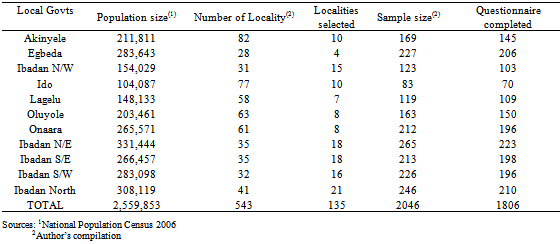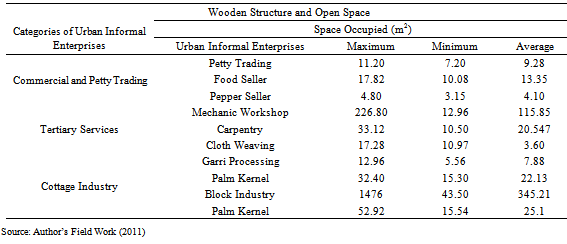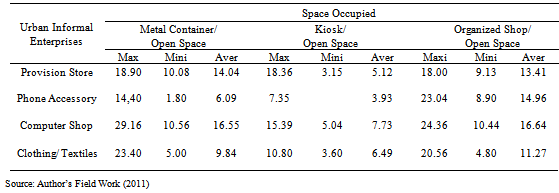-
Paper Information
- Next Paper
- Previous Paper
- Paper Submission
-
Journal Information
- About This Journal
- Editorial Board
- Current Issue
- Archive
- Author Guidelines
- Contact Us
World Environment
p-ISSN: 2163-1573 e-ISSN: 2163-1581
2013; 3(3): 85-93
doi:10.5923/j.env.20130303.03
Urban Informal Enterprises and Space Utilization in Ibadan, Nigeria
Abolade Olajoke, Adeboyejo A. T
Department of Urban and Regional Planning, Ladoke Akintola University of Technology Ogbomoso Nigeria
Correspondence to: Abolade Olajoke, Department of Urban and Regional Planning, Ladoke Akintola University of Technology Ogbomoso Nigeria.
| Email: |  |
Copyright © 2012 Scientific & Academic Publishing. All Rights Reserved.
This paper examines Urban Informal Enterprises and Utilization of Urban space in Ibadan metropolis. It determined total land coverage occupied by each urban informal enterprises and type of structure employed for business transaction.A total of 1,806 structured questionnaires were used to elicit information from operators in One hundred and fifteen (115) localities within the cosmopolitan region. Systematic sampling was employed to select respondents at interval of two.Descriptive statistical tool was used to summarize nominal data and chi-square was employed to examine the variation between dependent and independent variable. The findings reveal that average space occupied by each of this category i.e Commercial, Cottage and Tertiary Services ranges from 231. 42m2 to 345.2m2. Large proportion (67.9%) of urban informal enterprises in the study area makes use of temporary space most especially along the road setbacks, 23.5% carry out their business transactions on permanent space or organized shops. The study recommends a forceful implementation of development control measures through demolition of illegal structures while new policies and legislations should be formulated to accommodate and regulate the activities of informal enterprise within urban spaces. This will guide against its haphazard development and negative impact on the environment.
Keywords: Urban Informal Enterprises, Space, Utilization, Environment, Urban
Cite this paper: Abolade Olajoke, Adeboyejo A. T, Urban Informal Enterprises and Space Utilization in Ibadan, Nigeria, World Environment, Vol. 3 No. 3, 2013, pp. 85-93. doi: 10.5923/j.env.20130303.03.
Article Outline
1.Introduction and Statement of the Problem
- The modification of urban space within the ambit of marginalization and unequal access to opportunities in most African countries spurs the activities of the informal sector as a devise for resilient survival strategies[1]. From evidences that abound, most especially since the last two decades, there is an unprecedented and widespread proliferation of informal enterprises particularly in most cities of developing nations[2, 3] and Nigeria in particular. Consequently,the sector accounts for between 45% and 60% of urban labour force[4]. Urban informal enterprises follow closely the pattern of urban development in Nigeria and the areas of informality in cities are very extensive[4], although formal establishment agglomerate in many cities. The proliferation of several activities and services, including formal and informal enterprises like banking, insurance, educational, street trading, cottage industries, and petroleum stations, among others is a major characteristic of third world cities. However, it has brought a serious challenge to land use development thus stressing virtually all residential densities and posing a great threat to the environment andquality of lifeof urban dwellers. The location of such services is informed by areas where maximum profit can be derived. This has both positive and negative consequences on the area where it is located. For instance, it provides employment opportunity for the masses, source of livelihood for urban economically active population thus alleviating poverty for ill - educated and ill -trained[5]. However, given the well-known haphazard development pattern, (as locations pay no regard to any planning regulations) and associated insanitary environmental condition, the environmental impact of informal enterprises is obscene[6]. It was observed thatthere is infiltration of informal enterprises within virtually every segment of urban space particularly along major roads of cities[7]. The infiltration of such services, and enterprises (formal and informal) is not necessarily the problem but the haphazard location and its poor management through inappropriate policy measures as well as poor implementation of such policies to control and regulate the siting of such activities.Against the background of persistent and wide spread informal enterprises in virtually all the cities and its adverse implications on the environment, it becomes imperative to investigate the subject,its impact and implications as it affects the well-being of urban dwellers and the environmentin Ibadan, the capital of Oyo state and a major pre - colonial urban centre in South Western Region with vast population growth and spatial extent.This is the goal of this paper.
2. Literature Review
- The discussions on urban informal enterprises have received wide attention from scholars[4, 5, 7, 8, 9]. This is premised on its significant role in employment creation particularly in third world countries[10]. The International Labour organization (ILO) estimates that the proportion of the urban work force who engage in informal sector activities is highest in Sub-Sahara African, and account for more than 50% of urban employment in two thirds of countries surveyed in 1999[11]. In Africa, the predominance of UIEs is concentrated in Nigeria this stems from its massive population of 153.9% millions and decades of poor economic performance denoted by high unemployment rate of 12.9% and soaring poverty incidence of 54% while in the year 2000 the size of Nigerians informal sector was estimated at 57.9%[12, 13].Urban areas have become a center of gravity for all professionals, semi – professionals, skilled and unskilled labour around the catchment area[14]. This is often characterized by illegal development among which informal enterprise is the most predominant. Since most human activities have spatial dimension and coupled with the fact that there has been no considerable provision for land space to accommodate all the operators who engaged in urban informal enterprises, hence there is high demand for urban land and spaces for the accommodation of ever growing need of the sector, both to settle and trade. Consequently every suitable and available land space is converted to the use that suits the business activity thus resulting in erection of shops, kiosks and other temporary structures without formal approval. Therefore, virtually all informal developments are concentrated in urban areas with most of them being found in locations not approved or approvable by relevant town planning agencies thus constituting illegal developments.Development of informal sector follows closely the general pattern of urban development in Nigeria[4]. Each phases of its development in Nigeria cities reveals economic dynamism. Consequently, the development of this sector and its capacity to absolve a teeming population of the unemployed into the labour force has posed a considerable challenge to urban land use planning and management both in Nigeria and other developing countries[15]. These challenges and its associated benefits have been widely acknowledged in literature and have necessitated plethora of research work[2, 5, 8,16]. However, its manifestation through haphazard development becomes obvious with impaired pedestrian access, visual obstruction, road surface damage among others. This problem is undoubtedly as a result of ineffective and uncontrolled urban Planning. Thus its non-conformity toplanning regulations and standards coupled with its associated environmental degradation impact negatively on the urban environment and inhibit proper funding of the urban system[16]. Consequently, United Nations integrated urban management programme which focused on the development of urban management framework and tools on the issues of land management, municipal finance and administration as well as infrastructures and urban development[17] The development and incessant proliferation of Urban Informal Enterprises results in the unwieldy expansion of urban centers and this has been observed to pose serious threat to land use classification and planning[7] and coupled with this fact is provision and management of roads, drainage and sewage systems other infrastructure proves very difficult[9]. This continuous proliferation without corresponding increase in provision of urban amenities has indisputably caused decline in the environmental quality of such cities[8] as well its aesthetic value. This gradual deterioration is on the increase as urban informal enterprises are found on most public open spaces, road setbacks and medians in Lagos Metropolis. It has also been pointed out that a great challenge is borne out of the pattern of development especially in cities like Lagos, Ibadan, Enugu, to mention a few[4,6,7,9,11 ]. Most of these cities are associated with mega problems because they generate land use problems such as development of sprawl, incongruous land use, building alterations, the menace of temporary structures among others[18]. The worsening health and environmental problems of these cities are also caused by unregulated activities and indiscriminate disposal of waste from this sector of which, if allowed to continue, could make cities unlivable and unsustainable for present and future generations[4].The widespread of the unplanned and poorlyaccommodated informal enterprises in most parts of African cities make the collection, transportation, and proper treatment of municipal wastes extremely difficult. This is worsened with the general problems of lack of control over waste minimization, lack of appropriate landfill site and inadequacy of financial resources[19]. This could breed and exacerbate environmental problems and health hazards. Therefore, as the urban informal enterprises expand, there is bound to be a proliferation of workshops and work sites as well as intensification in the use of informal economic locations[20]. The resultant effect of this is vast deterioration of the environment. This can only be avoided if there is sound development control of land use activities. However, with the absence of development control, urban liveability becomes threatened. Therefore development control is required in the management of urban space as well as a tool to ensure compatible use of land. This will undoubtedly prevent environmental problems.
3. Material and Methods
|
4. Results and Discussion of Findings
4.1. Urban Informal Enterprises and Type of Space Employed for Business
- The availability of land or plots and workshops as well as the type of space and structure used to a large extent determines category and distribution of informal enterprises within any settlement. The type of space and structures as observed in the study could be temporary or permanent. Temporary space and structures are characterized by use of metal containers, wooden structures, kiosks, sheds or tents built with canopy and structures built with iron sheet. This undoubtedly, provides artificial security and protection from harsh weather condition like intense heat and heavy downpour or any other of such similar elements. These are strategically located especially near major land uses like banks, schools, hospitals, commercial areas, and specifically along transport routes. This is with the intention of providing service and supply of produce to the intended buyers. Those with permanent space and structures were characterized mostly by enterprises in organized shops, residential units with inbuilt shop or sometimes residential units that have been converted for such purpose.As shown in Figure1, there is a considerable variation in types of space where informal enterprises operate. In line with expectation, a large proportion (67.9%) of urban informal enterprises in the study area makes use of temporary space most especially along the road setbacks, 23.5% carry out their business transactions on permanent space or organized shops. Further analysis on space use by categories of Urban Informal Enterprises reveals that there is a wide disparity in the type of space employed to carry out their enterprises. For commercial and petty trading, 66.7% use temporary space (i.e. wooden structure, metal structure) while 22 .8% use permanent space and 10.5% use open space. Similarly, majority of those operating in cottage industry use temporary space (57.6%) and quite an appreciable proportion compared to those in commercial and petty trading and tertiary services use permanent space (31.8%) even though some still use open space (11.2%) especially those in cassava processing because of the nature of their work. The analysis also reveals that larger proportion of those in Tertiary services use temporary space (75.4%) while some use permanent space (21.6%) and open space (3.0%).The chi square result (p < 0.000) reveals a significant variation between types of space used by categories of urban informal enterprise. This finding supports facts established in some of the literature that virtually all formal andsemi informal business ventures employed permanent and organized structure for their business transaction whereas, reverse is the case for informal business enterprises. The factor responsible for employing temporary space could be as a result of ability to choose convenient sites so as to attract customer or because of proximity to homes of operators to enable them combine their work with household chores[13].The nature of space employed for urban informal enterprise in the study area is obviously because in most Nigerian cities, majority of road setbacks and other temporarily vacant plots are rented out by owners as spaces for urban informal enterprises. Again, the unavailability of serviced plots and structures for the operation of urban informal enterprises and coupled with the fact that spaces provided by government for business transactions tend to be grossly inadequate. It is equally surprising to gather information from government officials that government allocates temporary space to would be informal enterprise operators in order to generate fund as rent allowance to government pause. Further enquiry to confirm why government took such action revealed that the space were allocated to prevent indiscriminate disposal of waste and to discourage the space from being used as hide out for criminals or to prevent any other anti-social activities. This type of action further encourages utilization of temporary space for informal business transaction without considering the associated negative consequences.
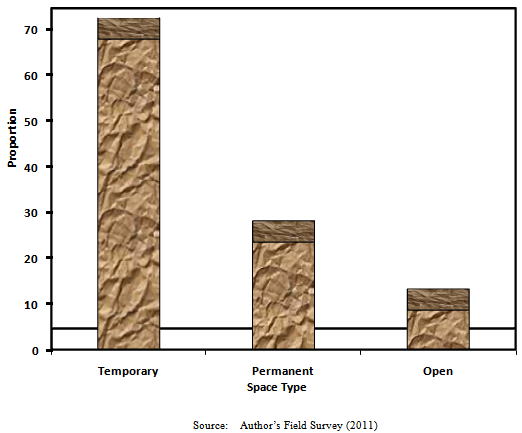 | Figure 1. Type of Space employedby Urban Informal Enterprises |
4.2. Categories of Urban Enterprises and Space Utilization
- The analysis on space utilization by different categories of Urban Informal Enterprises is presented in Table 2 and 3. This was determined by using measuring tape to calculate the length and breadth of the space occupied by different categories of urban informal enterprises. This was done to establish maximum and minimum space occupied, while the average was determined by dividing total space occupied by each category divided by total number of urban informal enterprises sampled in the study area. It is revealed from the analysis that those that employ wooden structure and open space for their operation fall into all the three categories of UIEs (i.e. Commercial and Petty Trading, Cottage industry and Tertiary services). It was however observed that those engage in block making, food vendor and repairs of automobiles occupy the largest space for their operation. The average spaces occupied by each of these categories were 345.21m2, 231.42m2, and 115.85m2 respectively for Commercial, Cottage and Tertiary Services. On the other hand, the enterprises that occupy the least average space are those involved in selling of perishable food and groceries. The space utilization by these categories of enterprises is unexpected because of the nature of operation that is associated with their enterprise. These results will assist in the allocation of urban space if government is to embark on such exercise for this type of business sector.The result on space occupied by those who use metal structure and kiosk reveals varying but a similar pattern with maximum and average space occupied. The result shows that the UIEs which occupy the highest maximum space is computer services and accessories (26.16m2),this is followed by those involved in cloth selling (23.40m2) and those involved in sale of provisions and other groceries. It is however observed that the calculated average space occupied by the same varied as presented in Table 3. Similarly, the same size of space was occupied by operators who employed kiosk for their business transaction. The result of space occupied by those who employ organized shop reveals a larger space for computer shop (24.36m2), phone accessories (23.04m2), clothing shop (20.56m2) and provision store (18.00m2) while the average calculated space follow the same distribution.
|
|
4.3. Types of Structures for Commercial and Petty Trading
- Different categories of urban informal enterprises employ diverse type of structures for their business transaction since there is no uniform or government approved prototype that each of this categories must employ. Consequently, operators choose type of structure to use based on what he feels is suitable and financially convenient. As illustrated in Figure 2, the bulk of those who engage in commercial and petty trades (41.7%) use wooden structure and open space. This is followed by those who employ metal structure and open space (26.5%) and the use of organized shop (24.1%). As observed from these findings, majority (75.8%) of operators in this category of business use temporary structures which in most cases are structurally poor and aesthetically unpleasing. Most of the enterprises are characterized with unauthorized construction of structures and buildings[14]. This invariably affects the aesthetic value and cause alterations in landuse particularly areas where such activities are located. Similarly since there is no organized or planned shopping mall to carry out such activities, the processes of managing waste from such enterprises will equally be at the discretion of each operator thus causing nuisance to the entire environscape.
4.4. Types of Structure for Cottage Industry
- As illustrated in Figure 3 virtually (87.8%) all those who are involved in cottage industry employ wooden structure and open space. The proportions of operators who use other types of structure are few. This finding is not surprising, since the operational procedure involved in this category of enterprises requires adequate space to carry out their activities. The haphazard location of structures and use of open space most especially the ones used for cassava processing, palm kernel making, among others causes environmental pollution and filth. It was equally observed that majority of them litter the ground with the liquid waste (plate 1). Most of this liquid waste generates offensive odour. Waste water is untreated and allowed to accumulate, the decomposition of its organic content can lead to the production of malodorous gases[15]. Similarly waste water if discharged directly into water courses or land could cause damage to all forms of life and it could present potential risk of transmission of large number of water related diseases, destroy and damage the crop planted and form breeding ponds for insects and other microorganisms which are harmful to man, plants and animals[16,17].
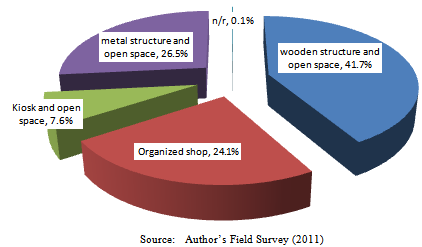 | Figure 2. Structure used for Commercial and Petty Trading |
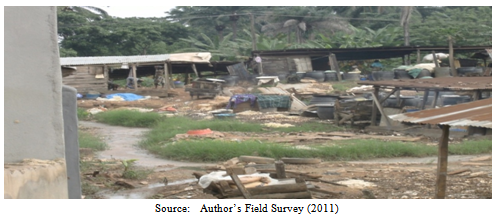 | Plate 1. Cassava processing and Fufu production at Onipepeye, Ibadan |
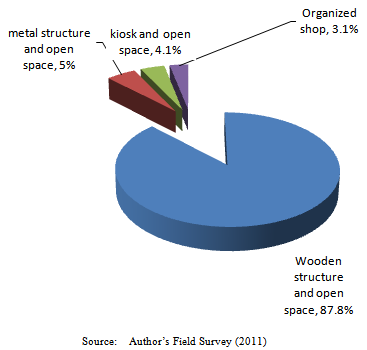 | Figure 3. Structures used for Cottage Industry |
4.5. Type of Structure for Tertiary Services
- Available results as illustrated in Figure 4 shows that majority (73%) of enterprises in tertiary services use wooden structure and open spaces while some use metal structure and open space (14.5%), organized shop (10%) and kiosk and open space (2.5%). This finding is expected because mechanics and other auto repairs (73.3%) are mostly predominant among tertiary services sampled in the study area. As observed during the reconnaissance survey, virtually all operators in this category employ open space for their repairs. This is often supported by wooden structure to keep some of their valuable tools for repairs.
 | Figure 4. Structure Used for Tertiary Service |
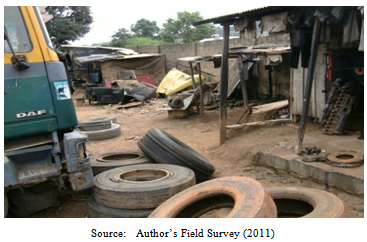 | Plate 2. Mechanic Workshop with wooden shed at Akinyele Local Government Sasa Idi ori |
5. Conclusions and Recommendations
- The paper has examined space utilization and different types of structures employed for urban informal enterprises. The space utilization is dependent on type of operation for different UIEs and the total space occupied by the same. The study has also established that most urban informal enterprises employ temporary space for their business transactions. This often result to haphazard developments and obstructs the functionality and aesthetic value of the environment. Therefore, the role of informal enterprises in providing employment and complementing the formal sector should not be trivialized when considering its effect on urban management system[8].The specific aim of land use planning is to arrange different structures and activities in space in a rational and environmentally sustainable manner to achieve health, convenience, economy, safety, and beauty[25]. To achieve this objective, three approaches for proper land use management are suggested, this include development control, planning schemes and development of master plan[26]. This approach will regulate and monitor land use development. Other related planning standard especially for commercial land use like urban informal enterprises should be developed and implemented strictly. This will discourage its haphazard development. Government via urban planners should educate informal sector operators on the effects of erecting structures on setbacks as well as violation of other planning regulations. There should be base line studies to obtain vital information on space utilization, structures used; this will help to formulate appropriate policies and programmes that will guide use of space and proper location of UIEs[16]. Provision for adequate and appropriate space through functional layout design in each neibourhoodshould be given priority for prospective urban informal transactions. This would have a long term effect in averting construction of legal structures in an illegal way in open spaces. Again, it is strongly suggested that the principle of multiple nuclei theory should be adopted for layout of a virgin or new areas, this will enhance provision of infrastructure such as markets at designated spaces to promote for various categories of urban informal enterprises. It will also discourage the infiltration of UIEs in already built up areas by decentralizing such activities into new growth pole[16]. Government at different levels should allocate fund while private developers should be encourage to invest in building shopping malls instead of investing in other land uses, this will undoubtedly promote proper ordering of different land use and generate income to the respective developer. The physical characteristics of urban informal enterprises with respect to design, condition and materials used to build structures must be revisited with respect to uniformity and appropriateness. The shopping mall or complex should be designed in such a way that similar goods or items should be located together and must be accessible to patrons coupled with adequate provision of basic infrastructures like electricity, water supply public toilets parking lots waste collection points among other relevant facilities This will encourage maximum demand and full maximimization of space. This becomes imperative because operators will only subscribe to locations with maximum patronage and marketability. Adequate provision of these facilities will reduce environmental problems like air, land and even noise pollutionSimilarly, there is need for appropriate guidelines to regulate and provide a framework for materials to be used as well as prototype design for various categories of urban informal enterprises depending on nature of activity. This will promote uniformity of design, material usage and enhance aesthetically and functional built environment. All this will undoubtedly guide against its chaotic and haphazard development and promote liveable built environment.
 Abstract
Abstract Reference
Reference Full-Text PDF
Full-Text PDF Full-text HTML
Full-text HTML